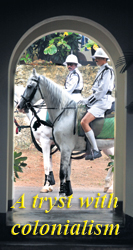|
|
||||||
|
A tryst with colonialism Mount Lavinia Hotel celebrates its bicentenary
with a touch of romance,
The steam engine bearing the inscription ‘Sir Thomas Maitland’ pulled into Mount Lavinia Station. Descendants of Sir Thomas Maitland and Sir Robert Brownrigg, former Governors of Ceylon and special invitees disembarked from the royally furnished ‘Viceroy’ carriage to a red carpet welcome. Mount Lavinia Hotel was celebrating its Bicentenary.
General Manager Bazeer Cassim received the distinguished guests while a concierge pulled the cart of metal trunks and crates, remarkably similar to those carried two centuries ago. Out stepped Dr. Doyle (played by actor Darrell Wallace) unexpectedly sent by Lord Camden of the Colonial Office. “I am here to investigate rumours of romantic trysts, a secret tunnel and a half naked dancing girl entertaining the Governor,” the gentleman dressed in period costume stated poker-faced, adding to the captivating portrayal of Mount Lavinia in 1805. There was more: Potted plants lined the path leading to the gates of the palatial building, the former home of governors. A colourful entourage comprising drummers, dancers and white horses led the procession through the gates of the hotel where a host of exquisite dancers performed, bringing back memories of Lovina Aponsua and other damsels who had danced for Governor Maitland 200 years ago. The sound of trumpets brought to an end the spectacular welcoming ceremony. This piece of the country’s colonial past was re-enacted at the Mount Lavinia Hotel on July 14 when portraits of British Governors of Sri Lanka between 1805 and 1831 - Lt. Gen. Edward Barnes (1819-1821 and 1824-1831), Gov. Edward Paget (1822-1823), Lady Sophia Brownrigg, Gen. Sir Robert Brownrigg (1812-1820) and Sir Thomas Maitland (1805-1811) were unveiled. The highlight of the event was the unveiling of a portrait of the mysterious Lovina Aponsua, said to be the low-caste dancing girl Sir Thomas fell in love with. British High Commissioner, Dominick Chilcott said the ghosts of the past governments were probably watching the ceremony. “Although our roles and powers are different, both took instructions from the Secretary of State, both worked in accordance with the British government policy and acted in the interest of the British government,” he said of the commonalities in their roles. For Henry Brownrigg, a descendant of Sir Robert Brownrigg, being at Mount Lavinia Hotel and viewing the bicentenary festivities took on a dreamlike quality. “Behind their uniforms, they were essentially human beings with human failings. While it is great to celebrate them, it would be wrong to glamorise them or demonise them,” he said. Viscount Ian Maitland (19th Earl of Lauderdale) who was here for the occasion spoke of the events that led his forefather to initiate the landmark building. On a lighter note he continued, “Watching the dancers, I can understand why Sir Thomas who was not the marrying kind went into the forbidden romance.” Mount Lavinia Hotel as part of its bicentenary celebrations launched a commemorative book ‘Mount Lavinia – the Governor’s Palace’ and opened its refurbished museum/gallery. Written by Shevanthie Goonasekera, the 136-page book published by London based Paradise Isle Publications run by two Sri Lankans provides information about the hotel’s history, architecture, occupants, festivities, etc.
|
||||||
Copyright © 2006 Wijeya Newspapers
Ltd. All rights reserved. |


